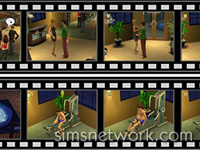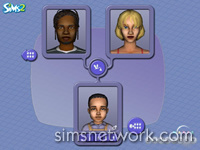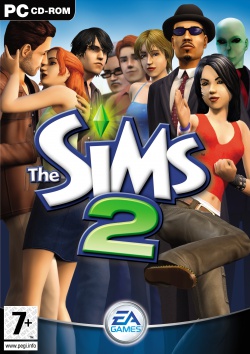Sims 2 Designer Diary
Tim LeTourneau, Senior Producer for The Sims 2 spills the beans about creating the sequal to the number one game of all time.
The Sims 2 Designer Diary #1
Senior producer Tim LeTourneau begins this new series of designer diaries on the sequel to the best-selling PC game of all time.
The Sims--a seemingly simple strategy game in which you control the lives of little computerized people known as "sims"--is reportedly the best-selling computer game ever, and the game has been supplemented with a series of substantial expansion packs. Though the final expansion pack for the original game, Makin' Magic, is now in development, the series' creators at Maxis concede that the original game has had a good run and that it's time to work on a full-fledged sequel. The Sims 2 will improve on plenty of different aspects of the original game--for instance, it will include the intriguing ability for sims to grow, change, and develop over time. The developers at Maxis have graciously agreed to chronicle their progress in this series of designer diaries. First up is senior producer Tim LeTourneau, who discusses the overall planning and design of this highly anticipated sequel.
The Big Picture
By Tim LeTourneau
Senior Producer
How do you create the sequel for the number one game of all time? Well, you start by understanding what it took to make it number one in the first place. Players love their sims, players love to build and decorate, and players love telling stories about what they've created in the game. That was where we began with The Sims 2.
 First, we needed a little of the Wright stuff. Will Wright, that is. Will had some definite ideas about where we should be taking The Sims 2. We then put together a team of veteran designers, producers, engineers, and artists--people who came from the original Sims and expansion pack teams. We needed people with an in-depth knowledge of the Sims simulator and behavior systems. Those people needed to have an intimate knowledge and understanding of the history of the franchise--a real grasp of what has historically worked and what hasn't. Most importantly, they needed to have the ability to put together and interpret all of gameplay feedback from everyone around them. Everybody considers themselves an expert on human behavior and, naturally, projects their own sensibilities onto the lives of their sims.
First, we needed a little of the Wright stuff. Will Wright, that is. Will had some definite ideas about where we should be taking The Sims 2. We then put together a team of veteran designers, producers, engineers, and artists--people who came from the original Sims and expansion pack teams. We needed people with an in-depth knowledge of the Sims simulator and behavior systems. Those people needed to have an intimate knowledge and understanding of the history of the franchise--a real grasp of what has historically worked and what hasn't. Most importantly, they needed to have the ability to put together and interpret all of gameplay feedback from everyone around them. Everybody considers themselves an expert on human behavior and, naturally, projects their own sensibilities onto the lives of their sims.
After assembling this crack team, we felt it was important to tap into the different stories that people tell about their life experiences. We had to determine how to deliver them in the game, since this is the essence of what gives us a game with universal appeal. In The Sims 2, everyone can find some part of it that they can completely relate to and emotionally connect with.
Then we tackled the sims themselves. We knew we wanted them to be more dynamic--to move and act more believably. We wanted players to experience a greater emotional connection to them. We wanted to get closer, and we needed a new game engine to accomplish that. As those systems progressed, the power that 3D graphics provided to the world of The Sims became clear. We now had the opportunity to truly evolve The Sims to the next generation with state-of-the-art graphics, animation, and artificial intelligence. The Sims 2 engine was born.
Now that we had the ability to deliver on our vision, we needed to innovate on the gameplay. Players had been asking us to let the sims grow up for a long time. It was clear that now we had the opportunity to explore that space. The term "next generation" took on a whole new meaning when we started to think about sims' generations. It radically expanded the playspace of the game and the scope and depth of the storytelling. We knew it would let players experience all of life's ups and downs with their sim families.
So what does a sim's lifetime look like? We decided on six distinct age ranges that make up the classic periods of life: babies, toddlers, children, teenagers, adults, and seniors. Each stage is punctuated by "big life moments," rites of passage we all equate with growing up: a toddler's first steps, a teen's first kiss, getting married, and kicking the bucket. Players will have to navigate through each of these stages and face the strategic challenges that each age presents. In this dynamic playspace, the best opportunities come when different age groups interact: the moody teen who torments her younger sibling, the crotchety grandpa who complains incessantly to his children, or the baby who throws up when played with a little too exuberantly by the baby-sitter. What happens to these sims as they grow through each of those stages deeply affects how they develop and the way they behave. To keep track of that development, we have given players a measurement called "life score." A sim's "life score" directly reflects the kind of life the player has helped the sim lead. Players will be rewarded for exploring both the positive and negative sides of life.
 Once we decided on generations as a theme, the rest of the pieces began falling into place. It became obvious that we needed smarter sims. They had to be more aware of and responsive to their surroundings, reacting when things happened in their world. They had to be able to better express their moods and feelings and form complex relationships. They had to have memory to distinguish between friends, family, and romantic interests. We wanted the sims in The Sims 2 to look and behave like their ancestors. We had to crack the Sims genome to let them pass traits from one generation to the next. When we got right down to it, we realized they just had to feel more alive and real so players could tell the story of their sims and their families across their lifetimes.
Once we decided on generations as a theme, the rest of the pieces began falling into place. It became obvious that we needed smarter sims. They had to be more aware of and responsive to their surroundings, reacting when things happened in their world. They had to be able to better express their moods and feelings and form complex relationships. They had to have memory to distinguish between friends, family, and romantic interests. We wanted the sims in The Sims 2 to look and behave like their ancestors. We had to crack the Sims genome to let them pass traits from one generation to the next. When we got right down to it, we realized they just had to feel more alive and real so players could tell the story of their sims and their families across their lifetimes.
As we added all the simulator support we needed for generational play, we also set out to revolutionize sim creation. In The Sims 2, create-a-sim has been taken to a whole new level of power. Players can now completely customize the facial features of their sims, making a truly unique person with just a few clicks. In addition to cosmetic choices like hairstyle and makeup, they can make genetic choices like hair color, eye color, and skin tone. But it doesn't stop there. In The Sims 2, players can now actually sculpt the faces of their sims without having to be artists. The control is nearly limitless; every aspect of the face can be customized according to the players' vision of who they want that sim to be. And on top of all that, the physical traits the player selects are passed down to the offspring. The sims have DNA!
We didn't want to leave any aspect of the game untouched. We knew that we needed to enhance and expand the build and buy modes beyond the scope of the original game. This is where many of the hard-core fans have spent literally hundreds of hours designing, building, and customizing homes for their sims. One of the first things that The Sims 2 players will notice is that they can now build houses with multiple stories. We have added the ability to construct decks and foundations. Players can now design and personalize their homes with all-new wall treatments and lighting options and can customize furniture with a variety of colors and fabrics.
So how do you create the sequel to the number one game of all time? You do it by having a deep understanding of your customer and your product. What I have tried to give you here is a quick overview of where we are headed with The Sims 2. In the coming months, we look forward to sharing with you the intimate details of the development process of The Sims 2, and believe me, some of them are going to be really intimate. From conception to delivery, we will allow you to experience, firsthand, the crazy, unpredictable ride of a lifetime that is the development of The Sims 2.














